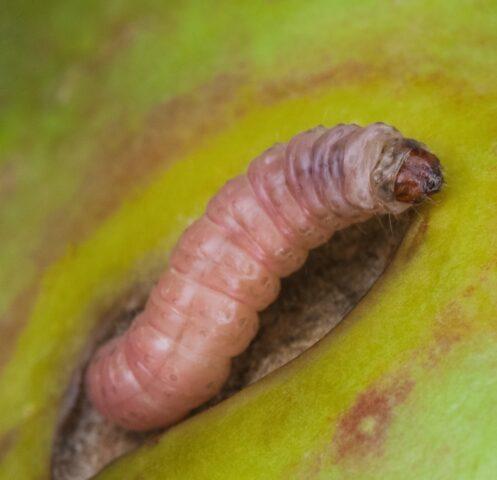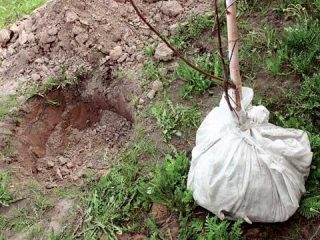Content
The codling moth is a dangerous pest that feeds on the pulp of apples, peaches, plums and other fruits. Can cause serious damage, up to 100% crop loss. Codling moth caterpillars and butterflies are ubiquitous and pose a danger to personal and farm households. To combat them, mechanical and agrotechnical methods are used, as well as special preparations and proven folk remedies.
Description of the codling moth
The codling moth is a dangerous pest from the order Lepidoptera (belongs to insects). It is a butterfly that infects apple trees and other garden trees. Distributed in most temperate regions. At the same time, in the northern regions and the middle zone it gives one generation, in the south - two, and in Central Asia - three at once.
The codling moth goes through several stages of development:
- The adult is a dark gray butterfly with a small wingspan (up to 2 cm). The body is also small – up to 1 cm in length. When an insect sits, its wings are folded together in a “house”.
- Eggs are shiny, translucent small balls with a diameter of up to 1 mm, and can be greenish-white in color.
- The larvae (caterpillars) are quite long (up to 2 cm). The color on the outside is flesh-pink, on the bottom – yellowish-white. Large scutes of light brown color are noticeable at the base of the body.
- The pupa is also visible to the naked eye. It reaches 12 mm in length, the color is light brown with a hint of gold. On the back side the abdomen has eight hook-shaped setae.
What crops does it affect?
The codling moth is distributed everywhere from Western Europe to the Far East. The habitat also covers Africa, the Middle East, North and South America and even Australia. The codling moth affects not only the apple tree, but also many other crops: pear, peach, plum, apricot, quince, walnut.

Codling moth caterpillars on an apple tree can be seen with the naked eye
What harm does
The name of the pest is due to the fact that it damages fruits. The caterpillars gnaw through the surface of the apple and feed on its juices and pulp. As a result, the fruits lag behind in development, become smaller and fall off over time. Such apples are unsuitable for food, even if used for processing.
The caterpillars enter the fruit through the petiole pit, as well as damage on the surface of the peel, often under the cover of the leaf blade. They can move freely between 2-3 apples if they are in close contact with each other. When the damaged fruit falls, the codling moth leaves it. After 1-2 days, it again rises along the tree trunk closer to the crown.
The insect is very voracious and can spoil literally all the fruits. It does not threaten the life of the apple tree, but significantly weakens the health of the plant. Crop losses if measures are not taken can reach 80-100%. Therefore, if pests are detected, they must be destroyed immediately.
It is better to wait until the next season, carefully remove all plant debris, and carry out several preventative treatments in early spring and summer.
Signs of the presence of codling moth
You can see the codling moth on an apple tree (pictured) visually. Among the main signs of damage are the following:
- the fruits become smaller;
- affected brown areas appear on the surface;
- when cutting into an apple, you can see reddish-brown rot and the caterpillar itself;
- the seed chamber is empty;
- there is a lot of dark excrement inside.

An apple fruit infected with a codling moth can be easily identified upon inspection.
When to treat apple trees for codling moths
During the season, the insect produces several generations. Therefore, for prevention and treatment, several sprays with drugs or folk remedies should be done. Experienced gardeners recommend using the following scheme as a basis:
- The first treatment of apple trees against codling moths is carried out in the spring, at the end of flowering (often in early June). You need to start spraying during the emergence of the first caterpillars, without waiting for their mass distribution.
- The second spraying is in the first ten days of July, when the second generation is formed.
- The third treatment is 15-20 days after the second. Those. already at the beginning of August.
The number of treatments can be up to seven times, it all depends on the characteristics of the particular variety. For early-ripening apple trees, three sprays are enough, for mid-ripening ones - four, for late ones, 5-7 treatments may be needed.
Methods for controlling codling moth on apple trees
You can fight the codling moth in different ways. First, the caterpillars are collected by hand - this is not so difficult if the infestation is minor. You can also use traps, after which you must treat them with drugs or folk remedies.
Mechanical method
This is the simplest and most effective way of fighting, with which treatment usually begins. Basic measures:
- collecting caterpillars by hand;
- destruction of wintering individuals under the bark of the trunk (the lower part of the trunk);
- installation of hunting belts, traps with pheromones;
- washing off the caterpillars with water (only at the end of the day to prevent sunburn).

At the first stage, codling moth caterpillars must be collected manually
Agrotechnical measures
To effectively prevent and get rid of apple moths, agrotechnical methods are also used:
- In spring and autumn, the trunk and branches are cleared of old bark.
- The containers from the collected apples are scalded with boiling water.
- The soil in the tree trunk circle is carefully dug up in the fall and treated with a fungicide.
- When shaking off or washing off the caterpillars, a thick cloth is laid on the ground, then the fallen moths are destroyed manually.
Chemical preparations for codling moths on apples
It is recommended to spray apple trees against codling moths with chemicals in cases where folk remedies do not help and the infestation is quite severe. They can also be used for preventive treatments in March, April and May. Among the main chemical insecticides against apple tree pests are the following:
- "Stozhar, RP";
- "Karbofos, KE";
- "Aliot, KE";
- "Herold, VSK";
- "Vantex, ISS";
- "Ditox, CE";
- "Alatar";
- "Calypso, KS";
- "Aktellik, KE";
- "Gladiator, KS";
- "Fufanon, KE";
- "Chord, CE";
- "Tanrek"
- "Confidor";
- "Ram"
- "Talstar";
- "Fastak".
- "Bi-58, KE" and others.
The preparations are dissolved in water according to the instructions, poured into a spray bottle and the total treatment of both sick and healthy apple trees begins. For the product to be as effective as possible, it is better to schedule spraying in the late evening, and the weather should be dry and calm.
Biological preparations for codling moths on apple trees
Biological preparations are used during apple tree fruiting. Their main advantage is short waiting times - 3-5 days. After this time, you can harvest without fear for your health.
The main biological preparations for codling moths:
- "Lepidocide";
- "Fitoverm";
- "Vertimek";
- "Bitoxibacillin."

Trichogramma are used to kill apple tree pests.
Small parasitic insects that feed on the eggs of the codling moth quickly multiply and prevent the spread of the pest, destroying it.

"Fitoverm" is one of the effective biological insecticides for the destruction of the apple moth
They lay larvae in the eggs of the moth.They are also used to destroy moths and leaf rollers.
Folk remedies for codling moth on apple trees
In gardening practice, folk remedies are also used for codling moth. They help in the early stages. They are used for prevention. Folk remedies are suitable for processing during fruiting. Among the most popular recipes are the following:
- Infusions of various herbs (1 kg per 10 liters of warm water) - burdock, wormwood, tansy, pine needles.
- Planting fragrant plants in the tree trunk or near it - dill, phacelia, anise.
- A decoction of 250 g of tobacco dust in 5 liters of hot water. You need to leave for two days, then boil and add another 5 liters of water. Strain and start processing.
How to protect an apple tree from moths
Fighting the codling moth on apple trees is more difficult than preventing the invasion. To minimize risks, it is recommended to follow basic preventive measures:
- In the spring, preventive treatment with insecticides is mandatory, even if there has been no invasion in recent years.
- In autumn, all fallen leaves and branches are carefully removed, taken away and burned.
- In the spring, sanitary pruning is carried out, removing old and dried branches. The sections are sprinkled with charcoal powder.
- For the winter, the tree trunk circles are covered with roofing material, film, or coconut fiber.
- In the spring, you can plant mustard or other green manure around the trees. They will not only prevent the invasion of the codling moth, but will also saturate the soil with valuable nitrogen compounds.
Conclusion
The codling moth can cause enormous damage. It is quite possible to completely control this insect. To do this, it is necessary to carefully observe preventive measures, and most importantly, carry out several treatments in spring and summer. It is best to use several products.Chemical and biological insecticides are suitable for control.








